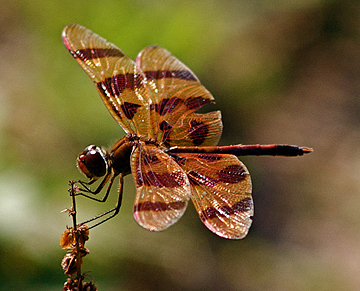Albertson Road, Winslow Township, NJ
Phone: (609) 984-1339
www.nj.gov/dep/njnlt/pennypot.htm
New Jersey Natural Lands Trust
Exit Winslow WMA and turn Left onto Piney Hollow Road. After 1.7 miles, turn Right onto an unmarked sand road just after passing under the Atlantic City Expressway. Proceed across the railroad tracks to the parking area for Penny Pot Preserve. DIRECTIONS FROM NEAREST HIGHWAY: From the intersection of Route 73 and Route 54 in Folsom, continue North on Route 73. After 3.2 miles, turn Right on Albertson Road. Just after passing under the Atlantic City Expressway, turn Right onto an unmarked sand road. Proceed across the railroad tracks to the parking area for Penny Pot Preserve. Map
 |
| Halloween Pennant | Greg Vizzi |
| |
| | Penny Pot Preserve is 382 acres of grassland, upland forest and wetlands adjacent to Winslow Wildlife Management Area and Wharton State Forest. Once slated for corporate development, the property was donated to the state in 1997. Some of the initial alterations are still visible in the form of cleared trees and ditched wetlands. Now nature has all but reclaimed the land. Sandy trails lead to clearings and wetland edges in the pitch pine, red maple and sweet gum lowlands along Penny Pot Stream, where a variety of rare plants, birds, reptiles, amphibians and other wildlife can be found.
White-tailed deer, foxes and raccoons can be tracked in the sand, along with other mammals. Raptors such as Red-tailed and Red-Shouldered Hawk can be spotted along the treelines. Wintering songbirds include Dark-eyed Junco, Carolina Wren, Cardinal and White-throated Sparrow. Wild Turkey can sometimes be spotted in the woods and in the fields across Albertson Road. Barred Owl can be heard and often seen at dawn and dusk.
Migrants, especially wood warblers and vireos, are arriving and singing. Listen for Northern Bobwhite whistling near the grassy clearing. Many wildflowers such as mountain laurel, swamp azalea, bird's foot violet, golden heather and blue toadflax are blooming. Spring peeper, Fowler’s Toad and Chorus Frog are among amphibians for which to look and listen. Insect repellent is always recommended.
Insect repellent is a priority against ticks and chiggers if visiting the woods. Breeding birds include Scarlet Tanager, Wood Thrush, Brown Thrasher, Prothonotary Warbler, Pine Warbler, Ovenbird and Wood Duck. Tree Swallows fly over the clearings by day, while bats take over at night. Many dragonflies and damselflies are about, such as green darner, slaty skimmer and Eastern pondhawk.
Some dragonflies and damselflies are still active, such as the ruby meadowhawk and assorted bluets. Wild cranberries are ripening along the pond edges. Many migrant birds are visible, as summer residents are leaving while winter residents are arriving.
|